jonka Starsha Bishop 1 vuosi sitten
143
Legalities and Funding

jonka Starsha Bishop 1 vuosi sitten
143

Lisää tämän kaltaisia
School boards must establish a SEAC. School boards provides an opportunity for SEAC to be heard by the board committee before the board makes any decisions about recommendations put forward by SEAC. School boards make available the personnel and facilities that the board considers necessary for the proper functioning of the committee. School boards provide SEAC members and their alternates with information and orientation within a reasonable time after a SEAC member is appointed.
SEAC operates locally within the area of jurisdiction of a board. SEAC is affiliated with an association or organization that is incorporated under federal or provincial law and not of professional educators SEAC operates throughout Ontario to further the interests and well-being of exceptional children or adults A new SEAC is formed every four years after the election of board trustees. Employees of a school board cannot be a member of the SEAC.
The board must ensure that the SEAC is provided with the opportunity to participate in the boards annual budget. The board must ensure that the SEAC is provided with the opportunity to review the financial statements of the board
SEAC provides important advice on special education to the local board SEAC makes recommendations to their board on anything that impacts the establishment, development and delivery of special education programs and services. SEAC may make recommendations to the school board on anything impacting the establishment, development and delivery of special education programs and services. SEAC may participate in the annual review of the boards special education plan. SEAC participates in the boards annual budget as it relates to special education.